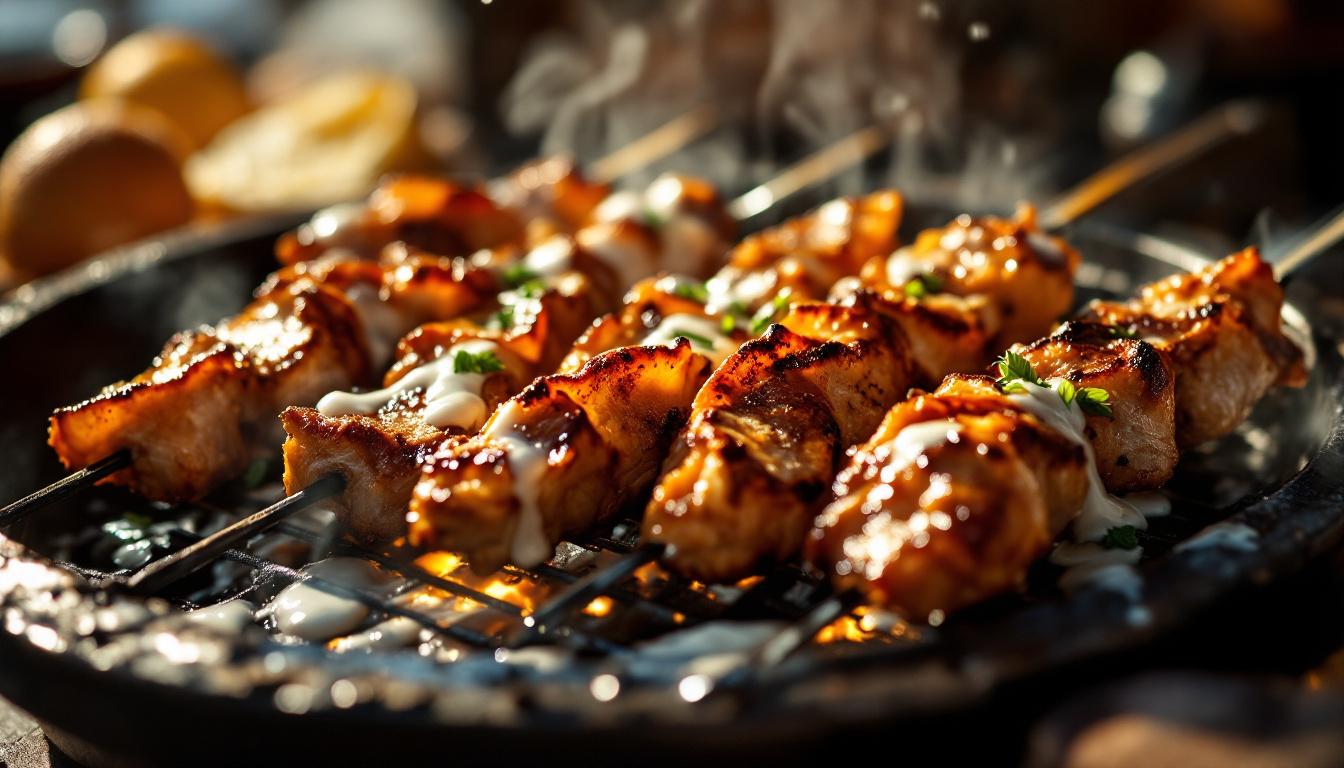Standing over the grill on my terrace in Istanbul years ago, I watched my host’s grandmother expertly flip thin slices of marinated lamb. “The secret,” she whispered, “is in the marriage of yogurt and fire.” That day changed my approach to kebabs forever. This isn’t just meat on a stick—it’s a centuries-old technique where tangy yogurt tenderizes protein before flames transform it into something transcendent. The accompanying cacik sauce—cool, garlicky, and refreshing—creates the perfect counterpoint to the charred, aromatic meat. What surprised me most? The incredible depth achieved from just a handful of ingredients.
The Story
Turkish kebabs represent culinary minimalism at its finest. Nomadic tribes developed these recipes out of necessity, using yogurt both as a tenderizing marinade and cooling sauce. What fascinates me is how this practical cooking method evolved into one of the world’s most beloved street foods without losing its soul. Unlike heavily sauced Western versions, authentic Turkish kebabs let quality ingredients speak for themselves.
Ingredients Spotlight
The marinade’s magic comes from yogurt’s lactic acid, which breaks down tough protein fibers while infusing flavor. Choose thick, full-fat yogurt—never nonfat—for both marinade and sauce. For the meat, lamb shoulder offers the ideal balance of lean meat and fat (beef chuck works beautifully too). The cucumber in cacik isn’t just filler; it provides essential freshness and texture. One ingredient people often overlook? The quality of your mint. Fresh is preferred, but if using dried, crush it between your fingers first to release its aromatic oils.
Step-by-Step Guide
For the Marinated Kebab:
- Combine 1 cup (250g) thick yogurt, 4 minced garlic cloves, 1 tsp (5g) ground cumin, 1 tsp (5g) paprika, 1 tsp (5g) salt, and ½ tsp (2g) black pepper in a bowl.
- Slice 1.5 lbs (680g) lamb shoulder or beef chuck into ¼-inch (0.6cm) thin strips.
- Massage the marinade into the meat, cover, and refrigerate for 12-24 hours (longer is better).
- Remove meat from refrigerator 30 minutes before cooking.
- Heat grill or cast-iron pan to high heat (450°F/230°C).
- Cook meat 2-3 minutes per side, brushing with olive oil.
For the Cacik Sauce:
- Grate 1 medium cucumber (about 2 cups/300g) and toss with ½ tsp salt.
- Place in a colander for 15 minutes, then squeeze firmly to remove excess water.
- Mix 2 cups (500g) thick yogurt, drained cucumber, 2 minced garlic cloves, 2 Tbsp (8g) chopped fresh mint (or 2 tsp dried), 1 Tbsp (15ml) olive oil, and salt to taste.
- Refrigerate for at least 30 minutes before serving.
Expert Techniques
The difference between good kebabs and transcendent ones lies in technique. First, don’t rush the marinade—a full 24-hour soak transforms the meat’s texture. Second, never overcook; aim for medium (135°F/57°C internal temperature) for lamb, medium-well (145°F/63°C) for beef. Finally, the grill should be screaming hot to achieve that perfect char while keeping the interior juicy.
Chef’s Note: Many home cooks skip salting and draining the cucumber for cacik. This is a critical mistake! Without this step, your sauce will become watery within minutes of serving. Those 15 minutes of draining time create the difference between a thin, separated sauce and a luxuriously thick one that clings perfectly to the meat.
Presentation & Pairing Ideas
For an impressive yet authentic presentation, layer the kebabs over warm, fluffy pita or focaccia. Drizzle with olive oil and sprinkle with sumac before serving the cacik alongside in a separate bowl. For a complete feast, pair with a tomato-cucumber salad, pickled red onions, and roasted peppers.
This kebab works beautifully with both red and white wines. For red, try a fruity Grenache or Syrah that won’t overpower the meat’s subtle spicing. For white, a crisp, unoaked option complements the yogurt beautifully. For an authentic experience, serve with ayran (a salted yogurt drink) or a light beer.
For a spectacular winter variation, transform this into a Turkish-inspired stew reminiscent of a bourguignon. Or for dessert, apply the same whisking technique from zabaione to create a modernized Turkish yogurt dessert, or finish with a chocolate mousse with Turkish coffee notes.
The beauty of this recipe lies in its adaptability. Once you understand the core technique—marinating in yogurt and cooking hot and fast—you can create countless variations. Try adding Aleppo pepper for heat, experiment with different herbs, or even use the marinade with chicken or fish. The recipes that have survived centuries do so because they’re both foolproof and flexible. Trust the process, but make it your own.
